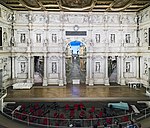Palazzo Chiericati
1680 establishments in ItalyAndrea Palladio buildingsHouses completed in 1680Museums in VicenzaPalaces in Vicenza ... and 1 more
World Heritage Sites in Italy

The Palazzo Chiericati is a Renaissance palace in Vicenza (northern Italy), designed by Andrea Palladio.
Excerpt from the Wikipedia article Palazzo Chiericati (License: CC BY-SA 3.0, Authors, Images).Palazzo Chiericati
Corso Andrea Palladio, Vicenza Santa Caterina
Geographical coordinates (GPS) Address External links Nearby Places Show on map
Geographical coordinates (GPS)
| Latitude | Longitude |
|---|---|
| N 45.549166666667 ° | E 11.549166666667 ° |
Address
Palazzo Chiericati
Corso Andrea Palladio
36100 Vicenza, Santa Caterina
Veneto, Italy
Open on Google Maps









